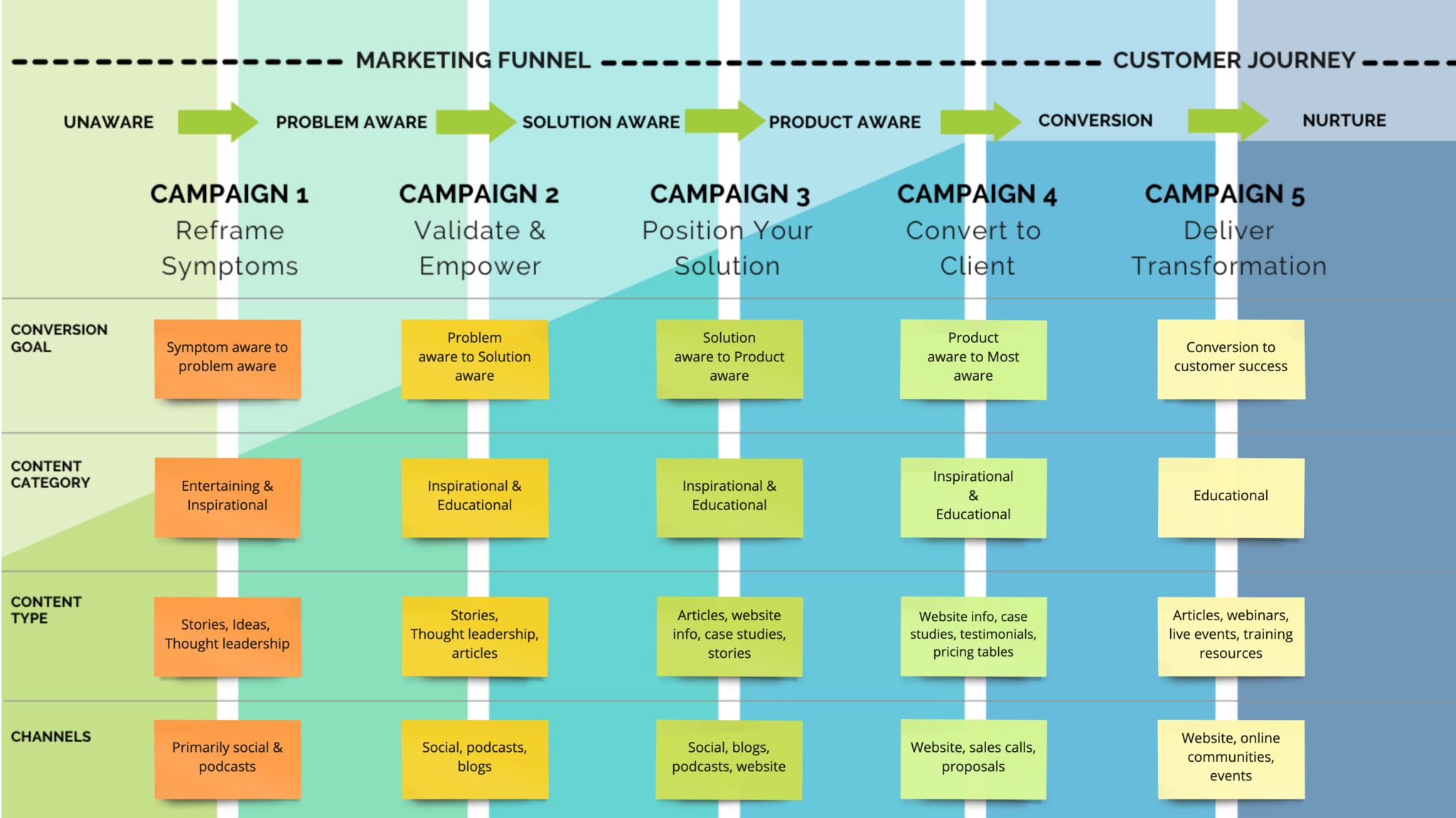ISSUE #3:
5 Content Campaigns
For a Successful Funnel
Dec 15, 2022
Read time: 3 minutes
I’m sure you’ve heard about the 5 stages of consumer awareness and how they map onto your sales funnel.
At the top of the funnel (TOFU), you target unaware prospects to make them problem aware. Next, you target problem aware prospects to make them solution aware… then product aware, then most aware, and then they reach the bottom of the funnel (BOFU) and convert. (In an ideal world.)
And although it’s almost never this smooth IRL, it’s a helpful way of breaking down the sales process into manageable campaigns with micro conversion goals that move people through their customer journey.
Let’s break down what these campaigns look like across your funnel:
Fuel Your Funnel with These 5 Campaigns...
Throughout your marketing funnel and customer journey, your main goal should be to coach your prospect’s transformation to help them reach their ultimate desired outcome.
And the best way to do that is by breaking the journey down into 5 content campaigns, each with a distinct micro conversion goal.

Campaign 1: Reframe
Now here’s where a lot of brands go wrong:
We’re often told that the first step at the top of the funnel is moving people from being “unaware” to “problem aware.” But that’s awfully ineffective. Because prospects who are truly unaware, generally won’t budge.
A better approach is to target your TOFU content at symptom aware prospects. So people who ARE experiencing a pain or problem, but haven’t connected that symptom with the underlying root cause.
Because by reframing their perceived pain or problems as symptoms of a greater (but solvable) root problem, you start positioning yourself as a trusted guide who can later help them solve their true problem.
So the micro conversion goal of campaign 1 is moving them from symptom aware to problem aware.
Campaign 2: Validate & Empower
Once your customer is truly problem aware, your next job is to help them navigate the solution landscape. And the best way to do that is NOT by simply listing different solutions and positioning your as the winner (another common mistake we see.)
Instead, show them why their previous attempts at solving their problem didn’t work (because they were band aid solutions) and help them let go of self-blame or judgement for past failures.
The key here is getting them to genuinely believe that a positive outcome IS achievable (with the right solution), and getting them excited about possible solutions.
So the micro conversion of campaign 2 is taking your problem aware prospect and empowering them to pursue a solution.
Campaign 3: Position your Solution
Once your prospect is open to the idea of trying another solution, it’s time to introduce your product or service and show them how it helps them reach their ultimate desired outcome.
This is where you use educational and sales content to overcome objections, demonstrate how your product tackles the root problem, and present its personal and professional benefits.
So the micro conversion goal of campaign 3 is channelling your prospects demand for a solution onto your product or service.
Campaign 4: Convert
Once you’ve ticked off the micro conversions in the first 3 campaigns, your prospect should be just about ready to buy. So this step shouldn’t be too difficult if you present the right information.
And that information can be summarised as the 3 Ps – Proof, Price, Push.
In other words, you need to reinforce risk of not taking action (what’s at stake) and reinforce the core beliefs and outcomes you’ve been pitching with PROOF.
Then you need to present your offer or offers with a PRICE.
And, lastly, you need to ask for the sale to push people across the line.
So the micro conversion here is the actual point of sale that turns your prospect into a customer.
Campaign 5: Deliver
And once all that is done, it’s time to deliver on your promise and truly guide your customer in achieving their outcome.
Of course, you’ll mainly do this with your product or service, but you should also consider supporting content like video tutorials, onboarding materials, community workshops, or whatever else might help your customer complete their transformation.
So your micro conversion goal here is turning your new customer into a successful, transformed customer, who may become a repeat customer or loyal brand advocate.
So there you have it, those are the 5 content campaigns that make a successful funnel.
By using this approach, you can break your funnel down into manageable chunks, and create effective content that clearly targets each micro conversion.
Pair this with a compelling brand messaging strategy, and you’ll have a powerful end-to-end content marketing engine that helps you build brand awareness, authority, and trust.
That’s it for today – I hope you enjoyed it, and I’ll catch you again next week.
If you want to build brand awareness, authority, and trust, your best bet is to start by nailing your brand story.
Whenever you are ready, there are 2 ways we can help you do that:
- Join The Storydriven Marketing Academy: Our FREE course that teaches you how to consistently nail your messaging across all brand assets
- Enquire about our Brand Storytelling Workshop: We work with you 1:1 over four guided workshop sessions to craft your storydriven brand messaging & content strategy
Straight to Your Inbox
Subscribe to the Storydriven Marketing Playbook to get the goods straight to your inbox!
We hate spam as much as you do, and we’ll never, ever sell your data!


